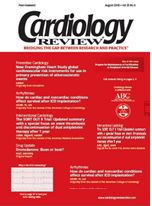Inflammatory markers and the risk of coronary heart disease
Yarnell and Patterson (page 37) provide a provocative report on the findings of a prospective cohort study of the association between inflammatory markers and the incidence of myocardial infarction. In this study, 4,325 men who were followed for 10 years underwent a baseline cardiovascular examination and laboratory studies. Based on an initial coronary heart disease (CHD) risk profile, the patients were characterized as being at high or low risk for future cardiac events.
The investigators performed logistic regression analyses, comparing a classic model of CHD risk factors to that of a model incorporating the following nonlipid risk factors: leukocyte count, serum viscosity, and fibrinogen level. The absolute risk for this hemostatic model was 35% in the high-risk group compared with 2% in the low-risk group, a finding comparable to that predicted in the lipid model (36% and 3%, respectively).
The investigators conclude that the use of inflammatory mediators, in addition to traditional risk factors for CHD, is as predictive of a cardiac event as a model incorporating lipids.
These findings highlight the growing role of inflammatory markers in CHD risk prediction. A meta-analysis of prospective data compiled in 1998 demonstrated a modest but highly statistically significant increase in risk of CHD for those subjects with higher baseline blood levels of fibrinogen, white blood cell count, and high- sensitivity C-reactive protein (hs-CRP).1
Based on the previously characterized pathophysiology of stress responses, it is not surprising that acute-phase reactants, such as fibrinogen and leukocyte count, would be elevated in the setting of an acute coronary syndrome. It is also biologically plausible that chronic elevation of these markers may be associated with an increased risk for future CHD events. Perhaps higher baseline blood levels of inflammatory mediators indicate a low level of chronic inflammation, a marker of plaque instability, and an increased risk of anatherothrombotic event. However, a pattern of causality is impossible to establish in observational studies alone.
While further studies are necessary to clarify the nature of the association between CHD and inflammatory mediators, the ease with which these inflammatory markers are determined in the laboratory and the relatively low cost of obtaining such tests may have important implications for monitoring those at risk for CHD. Additionally, fol-
lowing blood levels of inflammatory markers may have therapeutic implications. For example, a well-publicized analysis by Ridker and colleagues showed that patients with lower CRP levels after HMG-CoA reductase inhibitor (statin) therapy had better clinical cardiovascular outcomes than those with higher CRP levels irrespective of low-density lipoprotein cholesterol (LDL-C) levels achieved.2 This work supports the concepts that inflammation is a determinant of plaque stability and that statins have anti-inflammatory effects.
In addition, Nissen and colleagues performed an angiographic ultrasound study of 502 patients and found that a decrease in hs-CRP levels is independently and significantly correlated with the rate of atheroma progression.3 Patients with reductions in both LDL-C and CRP that were greater than the median had slower rates of progression than subjects with LDL-C and hs-CRP reductions that were less than the median. Thus, the reduced rate of progression was related to greater reductions in both atherogenic lipoproteins and hs-CRP.
The aforementioned studies offer compelling evidence that inflammatory markers can potentially be used at all stages of disease for risk stratification. Future studies will help determine if atherosclerosis should be added to the list of organ-specific autoimmune diseases.4 In the future, it may be possible to create anti-inflammatory agents that are tailored to specific immunologic abnormalities in the atheroma. Determining the precise mechanisms of actions of statins will help us in future drug development.5
